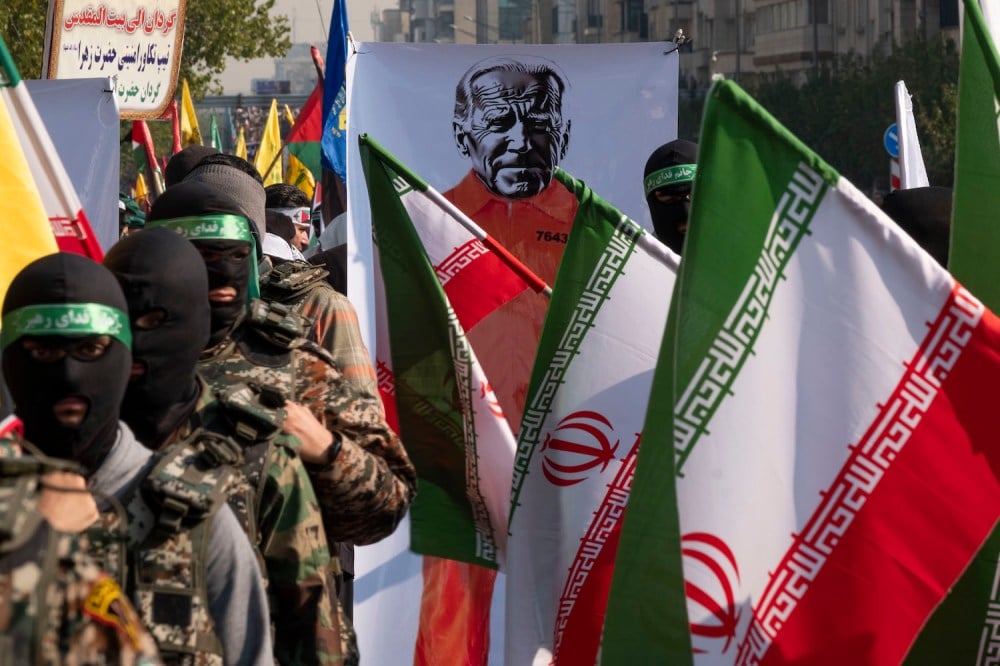November 8, 2023
Hamas’ barbaric October 7th attack did not happen in a vacuum. While their hatred of Israel and of Jews is permanent, the attack was enabled by an emboldened and enriched Iranian regime, responding to years of weak policy from the Biden administration. In the past month, Iranian proxies have attacked U.S. forces in the Middle East 40 times, earning only one response from Biden that killed no terrorists.
President Biden has abandoned deterrence in favor of policies that empowered the Iranian regime and its proxies to destabilize the Middle East with impunity. These decisions demonstrate a dangerous weakness that licenses Iran to harass and degrade US assets and interests in the region, including US citizens.
15 Key Actions Biden Took That Encouraged Iranian Aggression
January 20, 2021: President Biden canceled the Keystone XL pipeline and halted new federal drilling – these actions weakened the U.S. energy sector and contributed to higher global oil prices, enabling Iran to sell its illicit oil for even higher prices.
January 27, 2021: The U.S. announces a return to diplomacy with Iran – President Biden shows readiness to restart negotiations on the nuclear deal without preconditions, applying insufficient pressure on Iran for its regional and missile activities.
February 12, 2021: Biden’s State Department revokes the designation of the Yemeni Houthi rebels as a Foreign Terrorist Organization, despite their strong links to the Iranian regime and continued targeting of civilians across the region.
February 18, 2021: President Biden unilaterally removes travel restrictions against Iranian “diplomats” in New York City and cancels UN sanctions against Iran. This decision allowed Iran to legally buy and sell tanks, planes, submarines, and dangerous weapons across the globe. There was no Iranian concession in return.
June 2021: Biden officials engaged in “indirect talks” with the Iranian regime in Vienna, agreeing to talks with intermediaries instead of meeting in person, signaling a desperation for a deal, and showing weakness by agreeing to Iranian negotiating posture.
July 2021: President Biden announced a troop drawdown in Iraq, putting an end to the US combat presence in Iraq. Iran’s proxies perceived that their long campaign of rocket attacks resulting in the death of US persons was successful because it led to this troop drawdown and received no significant consequences from the US.
August 2021: The U.S. hastily withdraws from Afghanistan, turning the country over to the Taliban. The Taliban transfer and sell U.S. weapons over the border into Iran.
January 2022: On the eve of Putin’s invasion of Ukraine, the Biden Administration grants eight waivers for cooperation with Iran’s nuclear program, permitting a $10 billion nuclear deal between Iran and Russia to proceed. The State Department continued this lucrative waiver for Russia and Iran for an entire year before relenting under pressure from Polaris, but continues to grant the other seven waivers for Iran’s nuclear program.
March 2022: The Biden administration offers Iran enormous policy concessions, including lifting terror sanctions from the Central Bank of Iran and its oil export industries as well as against senior terror leaders- in exchange for Iran’s return to the JCPOA that includes no restrictions against its support for terrorism. Biden even contemplates lifting the terrorist designation of the Islamic Revolutionary Guard Corps (IRGC). Russian Ambassador Ulyanov brags that Iran “got much more than they could expect. Much more.”
July 2022: The administration fails to respond forcefully to Iranian drone attacks on U.S. forces in the region – the inaction signals the administration’s reluctance to confront Iranian aggression and attacks.
January 2023: The International Atomic Energy Agency finds Iran has enriched uranium up to 83.7 percent purity. The Biden Administration refuses to introduce censure resolution at the IAEA’s Board of Governors Meeting, and they have refused to take any serious action at the IAEA since Biden took office.
March 2023: Secretary of Defense Lloyd Austin tells Congress that Iranian-backed proxies have attacked U.S. forces 83 times since Biden took office, but that the United States has only responded four times.
August 2023: Biden administration officials admit that they have been secretly letting Iran export oil to China without sanctions, looking the other way in order to facilitate a secret hostage deal.
September 2023: The Biden Administration engages in the most expensive hostage payment in history, releasing five Iranian nationals convicted in U.S. courts and unfreezing $6 billion in assets in exchange for five U.S. hostages, rewarding Iran’s hostage taking and encouraging Hamas to believe it can negotiate handsome concessions for the release of hostages.
October 2023: Iran’s oil exports rise, despite sanctions – The administration’s poor enforcement of sanctions allows Iran to strengthen its economy and support militant groups, such as Hamas, which recently escalated attacks on Israel.
Key Takeaway - Biden’s series of conciliatory actions projected an image of U.S. leniency and submission, signaling to the Iranian regime that aggressive moves would meet minimal resistance.

